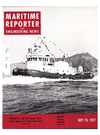
Papers On Navy C-P Propeller Program And Spray Patterns Of Jet Thrusters Discussed At Joint SNAME Chesapeake/ASNE Meeting
The Chesapeake Section of The Society of Naval Architects and Marine Engineers and the Flagship Section of The American Society of Naval Engineers held a joint meeting recently at the Officers Club of the Bethesda Naval Medical Center. The meeting featured the presentation of two papers — one on the U.S. Navy controllable-pitch propeller program, and the other a student paper on spray patterns produced by jet thrusters.
The presentation of papers followed a social hour and dinner attended by about 150 members.
The first part of the technical session was moderated by G. Boatwright of NAVSEC. The paper was entitled "U.S. Navy Controllable Pitch Propeller Programs," and was authored by Maurice Hauschildt, Richard Petros and Joseph Angelo. Mr. Hauschildt presented the paper, which described the U.S. Navy controllable- pitch propeller research and development program of the late 1960s and early 1970s. It discussed the failure of the USS Patterson (FF 1061) and the USS Barbey (FF-1088) research propellers, and the redesign and test of the Barbey propeller. It also discussed the Spruance (DD 963) propeller land-based tests and sea trials. The application of the data obtained from the R&D program to the DD 963, FFG 7 and future Navy designs was also discussed.
A discussion period followed the presentation of the paper.
The discussers included Capt. W.
Wvatt, DD 963 Program Manager, R. Rockwell, DTNSRDC, C. Noonan, DTNSRDC, and D. Ridley, Bird-Johnson Co.
The second paper, "Spray Patterns Produced by Vertical Disk Thrusters Above Water Surfaces," was written by George E. Selecman and Alan N. Jennings, both of whom are students in the Aerospace and Ocean Engineering Department of Virginia Polytechnic Institute and State University.
Jon Buck acted as moderator for this paper, which was presented by Mr. Selecman.
The paper presented an investigation of spray patterns produced by vertical disk thrusters over water surfaces. This work has application in understanding the spray which is likely to be produced by VTOL aircraft operating over water. The tests were conducted at DTNSRDC and at VPI. Qualitative analysis of test films from DTNSRDC led to experiments which showed a strong dependence of droplet size on Weber Number, Froude Number and the height of the disk thruster above the water surface. Dimensional analysis was used to devise a mathematical relationship between the most probable droplet size and the above mentioned parameters.
Other stories from July 15, 1977 issue
Content
- Proposal Calls For Ship's Spare Parts To Be Based Ashore page: 4
- Two Arabian Projects Totaling $80 Million To Great Lakes Dredge page: 6
- Raytheon Marine Opens New York Office page: 6
- G.E. Marine Gas Turbines To Power German Frigate Ships page: 7
- Western Union Int'l To Market New MARISAT System page: 8
- Skagit Corporation Appoints F.K. Weimann page: 8
- National Supply Builds 15,000-Psi Subsea BOP And Wellhead System page: 9
- Mamo II Joins Dillingham Fleet In Hawaii page: 10
- Lantana Boatyard To Build 134-Foot Alaskan Landing Craft Of Krogen Design page: 10
- Seven Seas Towing Names Capt. Cleveland Operations Manager page: 12
- Clay Chiles Awards Marathon LeTourneau 150-44-C Rig Contract page: 12
- San Francisco Hosts SNAME Spring Meeting And STAR Symposium page: 14
- Harland And Wolff Belfast Yard Building 333,000-Ton Tankers page: 16
- Thunderbolt Marine Industries Launches Twin 96-Foot Tugs For Panama Canal Services page: 17
- Moore McCormack And Aeron Marine Apply To Transport Oil For SPR page: 17
- Electro-Nav Now Sole U.S. Distributor Of BEN Speed Logs page: 18
- Robert L. Hague Post To Honor Admiral Rea page: 22
- International Paint Names Donald S. Otto page: 23
- Anixter-Mark Announces Five-Way Ratchet Mount page: 23
- SNAME Pacific Northwest Section Holds Joint Meeting With ASNE page: 24
- President Carter Presents $25,000 Prize For Energy-Saving Device page: 24
- MacGregor Publishes Ro-Ro Encyclopaedia page: 25
- New Shipyard Operating North Of Arctic Circle page: 26
- Dravo SteelShip Expands Facilities page: 28
- USCG Certified No-Discharge Oxidizing Toilet Now Available page: 28
- Tragosa Charters Seven Tidewater Vessels For Offshore Mexico page: 34
- De Laval Separator Issues Marine Brochure page: 34
- R.J. Reynolds Industries Elects McEvoy To Board page: 35
- American Abrasive Metals Announces New Non-Slip Roll-On Safety Coating page: 35
- Marine Surveyors To Hold 19th Marine Conference In New York In October page: 36
- ASNE Charleston Section Reports Activities page: 38
- Port Of New York Maritime Association Elects Officers page: 40
- Zapata Marine Realigns Marketing Group Posts page: 42
- Over 1,500 Attend ASNE Annual Meeting page: 42
- Seaworthy Engine Systems Appoints Jack E. Horner page: 43
- New Luxury Hotel Barge Begins Thames Cruises page: 43
- National Maritime Council Elects Barker Chairman page: 44
- Lincoln Warren Named ODECO Vice President Oil & Gas Exploration page: 45
- Papers On Navy C-P Propeller Program And Spray Patterns Of Jet Thrusters Discussed At Joint SNAME Chesapeake/ASNE Meeting page: 46
- Northwest Marine Iron Works Names Grider And Hiller page: 47
- Marine Electric RPD Markets Steering Gear Power Failure Alarm page: 47
- Equitable Delivers Ferry To State Of No. Carolina page: 48
- SNAME Chesapeake Section Elects Officers- Hears Paper On Domestic LNG Vessel Construction page: 49
- SNAME Los Angeles Section Honors Past Chairmen —Discusses Paper On Slow-Speed Marine Diesels page: 50

